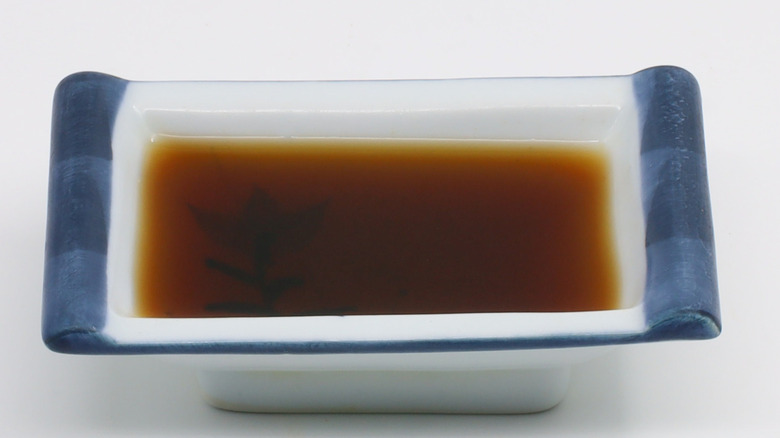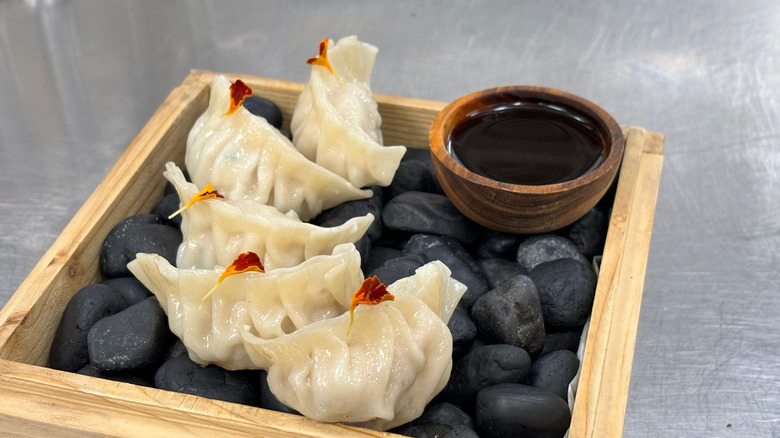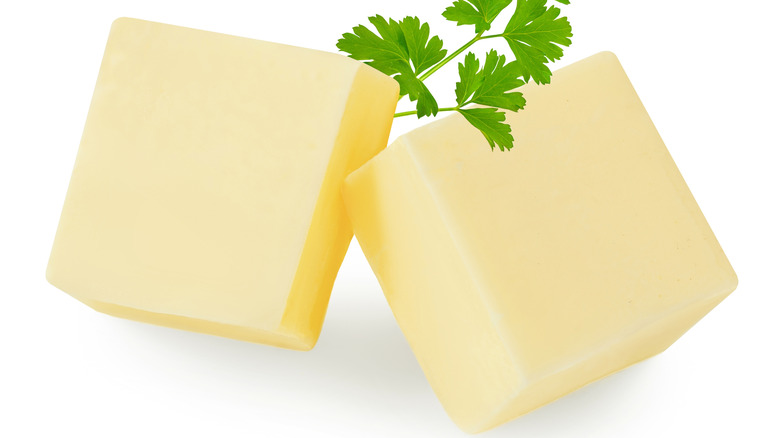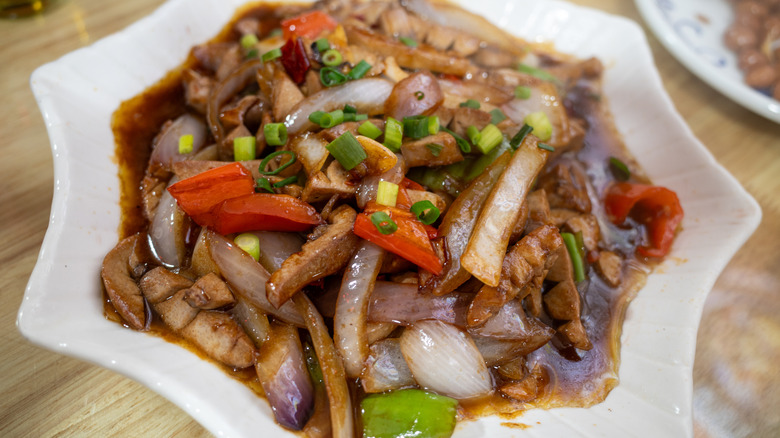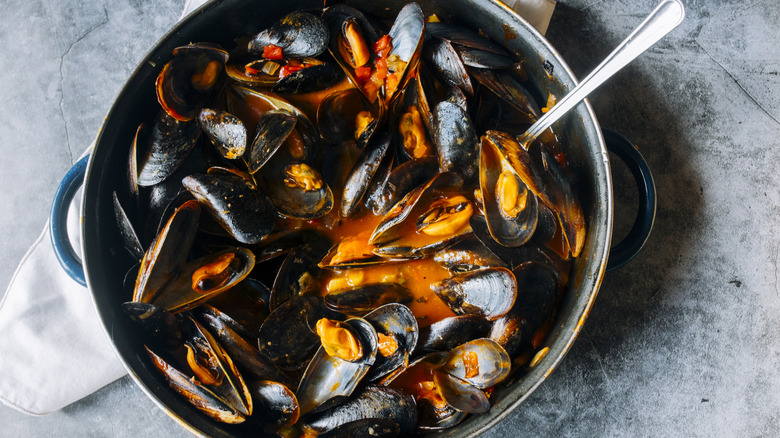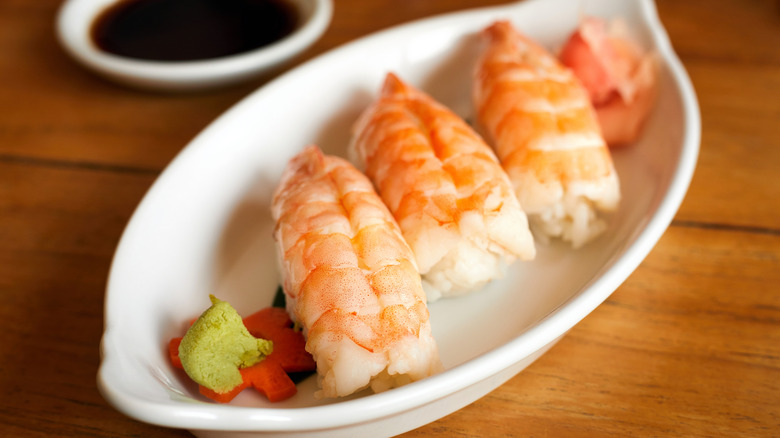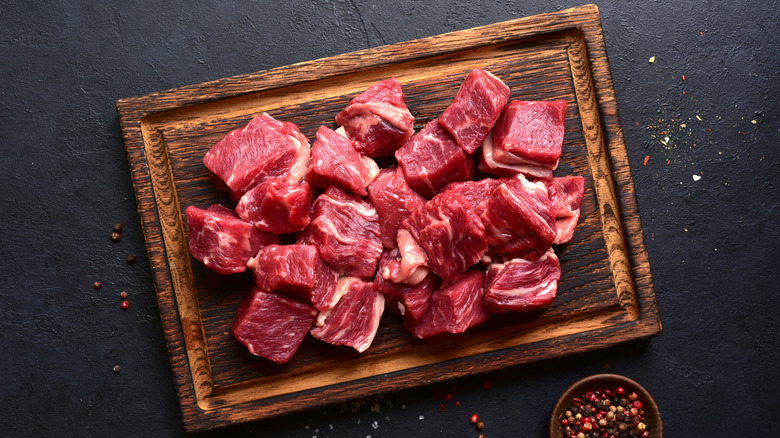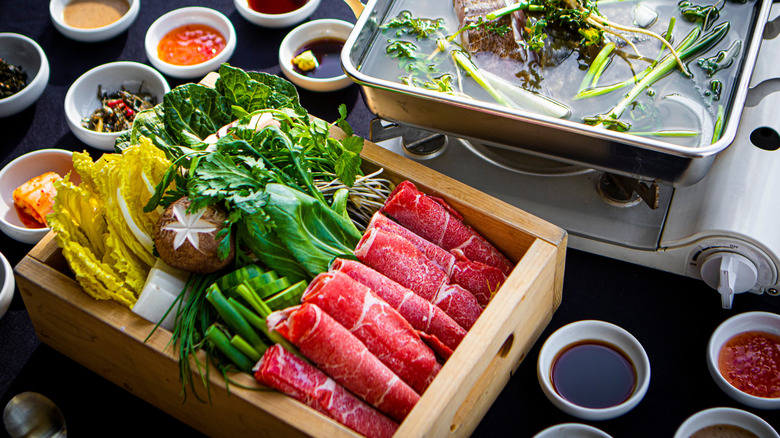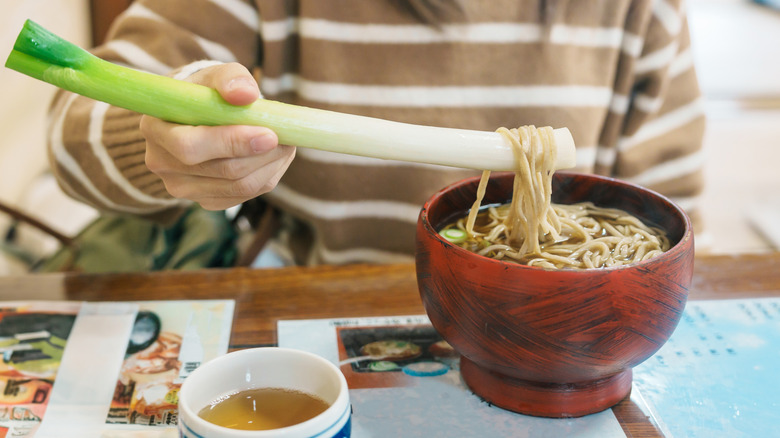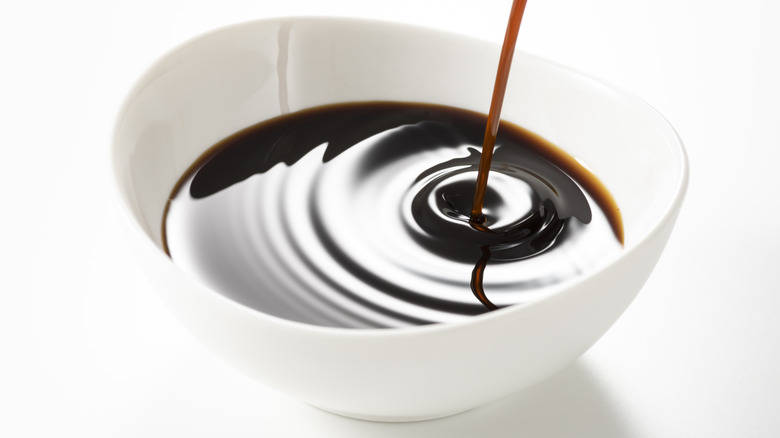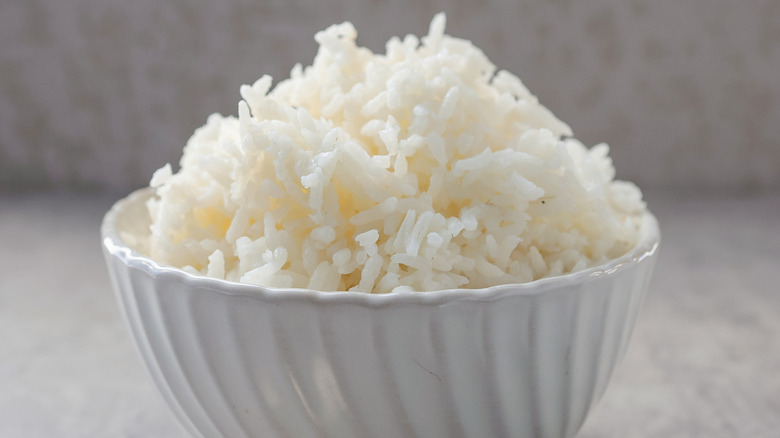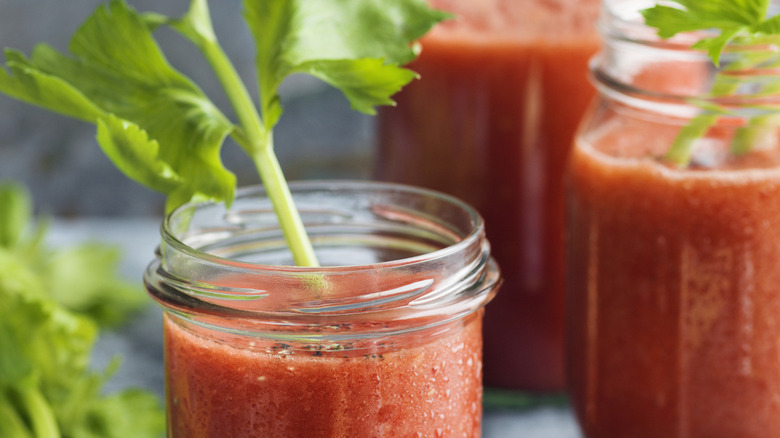14 Ways To Use Ponzu Sauce In Your Cooking
We may receive a commission on purchases made from links.
Ponzu is a traditional Japanese sauce with many possible applications. It works well as a sushi condiment, is a delightful upgrade to soy sauce, and even works as a substitute for ingredients such as Worcestershire sauce. Yet, for all its many perks, not enough people cook with it at home. And truly, there are many.
"Ponzu is a great substitute when you want both acidity and salt in one ingredient," explains Steffen Perico, chef de cuisine at Uchiko Plano. "Traditional ponzu, which includes bonito flakes, adds umami and depth of flavor, making it ideal for dressings and marinades. It brings complexity without requiring multiple ingredients." It has a deep history, Perico adds, stemming back to the 17th century when the Dutch traded in Japan. He explains that their word "pons" meant a citrus-based punch, influencing the name of the word today. "Over time, the sauce evolved into the tangy, umami-rich condiment we know today."
Plus, Shen Chen, founder of JOC Goods, adds that the ponzu flavor can vary widely depending on the recipe. "Most Japanese ponzu sauces are made with a blend of citrus like yuzu, sudachi, or kabosu, and each brand offers a unique balance of tartness, saltiness, and umami. If one didn't quite suit your taste, don't give up."
Along with experimenting with types, you should also experiment with ways to use it in your cooking. Ponzu brings a nice citrus zing to steak, complements traditional Japanese tuna dishes, works well as a topping for raw oysters and more. Here are 14 ways to start using it today.
Put it in your salad dressing
"Ponzu makes for a great salad dressing," says Rachel Kirk, recipe developer at Laughing Spatula. "You can make a creamy Asian vinaigrette by combining Kewpie mayo, ponzu, honey, and sesame oil. You can also use ponzu in place of vinegar when making an easy vinaigrette dressing." The salty, citrus flavor of ponzu also combines with other traditional Asian flavors, says Jem Mantiri, the recipe developer and food photographer behind Jem Mantiri: "Whisk ponzu with a bit of sesame oil, a touch of maple syrup, and some grated garlic or ginger. It's zippy, balanced, and instantly gives your greens a boost."
The same basic ingredient combination makes an equally good vinaigrette for cabbage slaws or cold soba noodles, says Shruthi Baskaran-Makanju, recipe developer at Urban Farmie. Or, says Shen Chen, with earthy salad ingredients such as mizuna, daikon, and arugula. It's also a great accompaniment to plain old, trusty, juicy summer tomatoes.
If you want, you can update the classic green goddess dressing, Steffen Perico says, giving it "a bright, Japanese-inspired twist. It's a great way to introduce complexity and a global touch to familiar recipes." Options such as Marukan Ponzu Yuzu Soy Citrus Dressing or Kikkoman Ponzu Citrus Soy Sauce are both good ones to try.
Use it as a dip
One of the best — and easiest — ways to use ponzu is simply as a dipping sauce, no mixology needed. Indeed, says Andrew Hunter, executive chef at Kikkoman, this is its traditional use, and it's one of the most delicious ways to finish tempura, dumplings, and steamed veggies. Veggie spring rolls are another great vehicle for ponzu, Shruthi Baskaran-Makanju adds.
You needn't serve it plain as a dip, however. "Ponzu pairs well with cold tofu or can be mixed with grated daikon and scallions for a dipping sauce," explains Jarren San Jose, Edomae sushi expert at The Sushi Geek. "It's also found as a dip for certain cold starters like ankimo (monkfish liver)." Or, advises Rachel Kirk, "Mix it into Kewpie mayonnaise with a little bit of wasabi for a sushi dip. Serve it on the side of fresh spring rolls to dip."
It's nice to keep the dip cold, Steffen Perico says. It provides a nice contrast to hot foods, while you can serve spring rolls and noodles, either hot or cold, with ponzu.
Make ponzu butter or other condiments
Ponzu's citrusy tang is the perfect complement to the rich, creamy sweetness of butter. "Blend it into soft butter and herbs for a compound butter that melts beautifully over seafood or noodles," says Kyle Taylor, the recipe developer behind He Cooks. You needn't use soft butter if you don't wish, though: Ponzu sauce also blends nicely into melted butter for grilled lobster, shrimp, or scallops, says Rima Kleiner, the registered dietitian behind Dish on Fish.
Another creamy condiment idea? Ponzu aioli. "Blend ponzu with mayo or Greek yogurt for a creamy dipping sauce that pairs beautifully with fried calamari or crab cakes," Kleiner advises. Straus Family Creamery Plain Greek Yogurt or Chobani Non-Fat Plain Greek Yogurt would both make a great base.
Not enough ponzu suggestions for you? There's always mayo, of course. "I love mixing it into mayo for a sandwich spread (especially with avocado and sprouts) or using it to season smashed edamame or white bean dips," Shruthi Baskaran-Makanju says. She also likes it mixed with melted butter and brushed on corn. "Seriously easy way to totally make something feel gourmet!"
Throw it in your marinades
Citrus is a popular choice for marinades, and so is salt, so it's no real surprise that ponzu sauce would be a good ingredient as well. "You can think of ponzu as a citrusy, umami-packed substitute anywhere you would use salt, just with more sweetness and acidity," Andrew Hunter says.
However, the citrus element is mild, which is important. More specifically, "It isn't in such a great quantity to where it will toughen up what it's marinating," Rachel Kirk says, explaining that "if you marinate chicken in lemon juice it can make it tough, and if you marinate fish in lemon juice it will cook it similar to ceviche." Ponzu, rather, has enough citrus to be flavorful without changing the texture of the proteins.
Note that if you leave it too long, though, it can still begin to cook raw fish, Jarren San Jose says, so be quick about it. For other meats, the concern is lower. One fun approach is to "Combine it with garlic and oil for a quick marinade before grilling," Kyle Taylor says.
Add it to your stir-fries
Ponzu is traditionally used cold as a condiment or dipping sauce. However, it has its place in hot food as well. "I don't use ponzu very often in hot applications," Shruthi Baskaran-Makanju says, "but the one place where I do use it is at the end of a stir-fry, so it doesn't cook off and gives a super fresh hit of flavor."
Plus, Rachel Kirk says you can use it a bit more generously than you would soy sauce since it doesn't get as salty as quickly. That's not to say the salt won't concentrate at all, though, so you should still be careful, she cautions. Use a light hand when adding it: "You can always add too, but you can't take away when cooking." Sprinkle on a bit, taste, and sprinkle on a bit more. That way, you won't go over the edge before you know it.
Sprinkle it on fish and chips
Speaking of sprinkling, ponzu makes a great update for malt vinegar or lemon juice on fish and chips. "It enhances the crispy batter while adding a subtle umami boost," Rima Kleiner says. The result, Kyle Taylor says, is a more complex result than you'd get from either of the more common approaches in American or British cooking.
Andrew Hunter also loves it on fish and chips, but with a twist: He likes to combine it with cider vinegar for a light and fruity addition that brings a little bit of sodium at the same time. Plus, since the species traditionally used in fish and chips (such as cod and halibut) are so delicate, they take well to the complex yet mild flavor of ponzu.
Use it in hot seafood dishes
Ponzu shines in seafood dishes, and there is no end to its applications here. According to Rima Kleiner, you can use it as a finishing sauce for stir-fried shrimp or deglaze a pan after searing scallops to create a citrus-scented sauce. Sub it for white wine in steamed mussels or clams, serve your ponzu aioli with calamari, or brush it on fresh fish before smoking it. That's not all. "Brush ponzu over salmon, cod, or snapper before grilling or baking to enhance caramelization and add a citrusy glaze," Kleiner suggests, or "Reduce ponzu with brown sugar and/or a touch of honey to create a glaze for seared scallops or grilled salmon."
The list continues: "It's also a perfect match for bold seafood such as king crab legs and fresh oysters, where its citrusy sharpness balances the natural brininess," Shen Chen says. He also loves broiled hamachi kama, yellowtail collar, dipped in ponzu. "It's super simple and quick and always a crowd favorite." Yuzu ponzu aioli is also a wonderful way to complement halibut collar, whose flaky, tender meat is an excellent vector of the salty, citrus flavor, Andrew Hunter says.
Lastly, Chen shares, "One of our kids' all-time favorite dishes is salmon foil packets — just butter, mushrooms, onions, and a drizzle of ponzu to finish. The ponzu cuts through the richness of the salmon and ties all the flavors together beautifully."
Finish sashimi and cold seafood with it
Again, ponzu is fantastic as a cold ingredient added at the end of finished dishes, and nowhere is this truer than in the case of seafood. "It combines a little tangy, a little salty, and a little sweet all in one bite," Rima Kleiner explains. "Use ponzu instead of traditional citrus juice to marinate seafood, adding complexity to the dish," or "Toss chilled shrimp or crab meat with ponzu, fresh herbs, and a touch of sesame oil for a light appetizer." You can also ditch the mignonette and cocktail sauce and dress up oysters on the half-shell with ponzu dressing instead. It's a great complement to the oysters' natural briny sweetness.
Jarren San Jose explains that in Edomae omakase, which is essentially a light sushi-tasting menu, "ponzu is not a general-purpose sauce, but may be used as a precise brushstroke. It's applied when the chef wants to add a clean, bright note that enhances — but never masks — the umami and texture of the fish." Sometimes, he adds, it's paired with grated wasabi to enhance the fish without overpowering it.
At his restaurant, Steffen Perico likes to use ponzu sauce with yellowtail sashimi, Thai chilies, orange supremes (sections of orange with the membrane removed), and orange oil. "The ponzu brings brightness and depth that ties everything together beautifully," he says.
Enhance the flavor of other proteins
While ponzu and seafood are perfect bedfellows, it works well for other proteins, too. For instance, says Rachel Kirk, you can "Reduce it down to a glaze and smother it over pork chops." If you want a quick veggie dish, try drizzling it over silken tofu (recommended by Shruthi Baskaran-Makanju). She pairs the combo with scallions and sesame seeds to make a high-protein dinner in only a few minutes. It's an ideal recipe when you don't feel like cooking.
And, Shen Chen says, "The citrusy kick of ponzu pairs exceptionally well with fatty meats, making it a classic choice for dishes like Japanese-style hamburger steak (wafu hambagu) topped with grated daikon. It helps balance the richness and adds a refreshing contrast." You can use it as a finishing sauce for steak cubes, like saikoro steak, he says, or substitute it for lemon juice in marinades or other recipes. Just always remember that it contains salt, so you can't do a straight-across citrus substitute; you'll have to balance the sodium.
Serve it with shabu-shabu or soup
Another hot application for ponzu sauce is soup, but you've got to do it carefully. One of the traditional uses of it is with shabu shabu, a Japanese hot pot. "The acidity cuts through fattier meats and balances earthy vegetables," Jarren San Jose explains. "Some may add green onions or grated daikon to enhance the flavor."
Shabu shabu is a highly communal experience in which diners dip raw, prepped veggies and sliced meats into boiling broth until they're lightly cooked. They then pull them out and dip them in ponzu or sesame sauce. If you want to try a Japanese hot pot yourself, you can find one online for an affordable price, such as the Sonya 5L Electric Dual-Sided Shabu Shabu & Mongolian Hot Pot.
However, it works well in other types of soup. Shruthi Baskaran-Makanju likes it to brighten up minestrone or Mulligatawny at the end, while Rachel Kirk enjoys it in miso soup. For Andrew Hunter, hot and sour noodle soup also does well with a hit of ponzu.
Season your noodles with it
Like soup or stir-fries, ponzu works well as a dash of seasoning at the end of cooking noodles. That way, Steffen Perico says, you keep its bright flavor intact rather than cooking it off. "A quick drizzle of ponzu not only adds a burst of salt and acidity but also gives the dish a slight caramel hue that enhances its visual appeal," Perico adds. "It's a simple way to elevate both flavor and presentation."
Cold soba noodles also embrace the flavor of ponzu, Jarren San Jose says, and Andrew Hunter enjoys it on his ramen. According to him, it's the "perfect blend of savory, sweet, tangy, and plenty of umami." Another flavor profile in which ponzu sauce is quite at home is Italian. Perico loves it combined with cremini mushrooms and butter on pasta. "It gives them a rich umami depth with a subtle tang," he says.
Sub it for salt, soy sauce, Worcestershire, vinegar, or citrus
One of the best reasons to keep ponzu sauce around is that you can use it in place of other ingredients. "Ponzu works great instead of soy sauce when you want lighter, brighter results," Kyle Taylor says. "It can replace vinegar or citrus when you need more depth and complexity. Ponzu provides salt, acid, and umami depth for countless applications."
But beware: Although you can use them in many of the same applications, there is a significant difference between ponzu and soy sauce. "Use ponzu sparingly as it's more potent than soy sauce," Taylor adds. "Different brands vary significantly in citrus intensity and smokiness. Always taste your ponzu before adding it to understand your work." Also, Shen Chen adds that it doesn't have the same deep, rich, brownish-black color as soy sauce, so "ponzu may result in an unexpected outcome."
Soy sauce and salt aren't the only ingredients you can sub out in favor of ponzu — it also works as an elevated alternative to Worcestershire sauce in dressings or dips, Jarren San Jose says. And Rima Kleiner says, "Ponzu's citrusy acidity makes it a great alternative to lemon juice or vinegar. It adds complexity while keeping the dish light and refreshing." In the case of lemon juice or vinegar, the color problem is the opposite: It may darken dishes that are meant to stay light, so watch the final result.
Don't confine yourself to Far Asian cuisines, either. "Ponzu is very international because the high notes are citrus supported with umami. Thus, it's compatible with food on all the continents," Andrew Hunter says.
Jazz up your rice
Is there anything more comforting than a warm, fragrant, tender bowl of rice? (Would anyone ask that question if their answer was "yes"?) If you've been looking for ways to amp up your rice bowls, then ponzu sauce could be it. "Drizzle a little ponzu over plain rice or mix it into fried rice," Jem Mantiri recommends. "It adds a subtle tang and umami that makes the rice feel more exciting." If you want, Kyle Taylor adds, "Combine it with a jammy egg and scallions over warm rice for an instant comfort food upgrade."
Per usual, remember not to add too much: It can get salty quickly and suffocate the other ingredients in your bowl. But conversely, Jarren San Jose says, "Ponzu is delicate, and drowning a dish in it can mute its complexity. It should always complement, not overwhelm." You can make sure this doesn't happen by experimenting with different types of ponzu. Some include soy sauce, and some don't.
Take your Bloody Mary to the next level
"Ponzu adds a unique dimension to Bloody Marys when you're looking for something different," Kyle Taylor says. One recipe combines vodka, tomato juice, yuzu juice, soy sauce, pepper, and ponzu sauce, then offers a range of possible garnishes: celery sticks, cucumber ribbons, pickled veg, olives, and cherry tomatoes. Or, if you're feeling high-spirited, all of them at once.
Of course, if you're feeling less-than-high-spirited, you could always use a mix. Try a product such as Mr & Mrs T Original Bloody Mary Mix or, if you want a more upscale experience, Demitri's Classic Bloody Mary Seasoning Mix. Then dash in some ponzu to taste and save your energy to class up your drink with ice and garnishes.
Bloody Marys or other drinks may prove another fun opportunity to experiment with types of ponzu sauce since there are so many different flavor profiles to combine with the sharp, acidic nature of the classic brunch drink. When experimenting, Rachel Kirk advises you, "Check out your local Japanese market for the most authentic ponzu sauces." Other grocery stores call for more caution, she says: "Be wary of flavored ponzu sauces — they're most typically just a flavored bottle of hard-to-pronounce ingredients."
